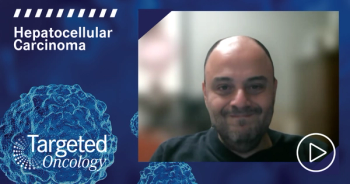
Richard Finn, MD: Possible Systemic Therapy in a uHCC Patient
Would you consider systemic therapy in this patient?
At progression, this patient clearly is a candidate for systemic treatment. When consider systemic treatment, again, the only approved drug and has stood the test of time now since its approval in 2008 is sorafenib. Sorafenib is an oral multi-kinase inhibitor with activity against the VEGF receptor and has been shown to improve survival in patients such as this, specifically patients who have macrovascular invasion, or patients who have extrahepatic spread, or both.
There’s been numerous clinical studies challenging sorafenib and no drug has been able to be approved in the frontline setting. With that being said, there are always drugs in development then(?) for patients like this who are well compensated and active, good performance status. They should be considered for a clinical study. Most of these studies would be sorafenib versus a new agent or the combination of sorafenib and a novel agent.
What’s interesting about the use of sorafenib in liver cancer is it is not a drug that induces a high response rate. The majority of its benefit is from inducing stabilization of disease and slowing progression. Typically, these patients are followed with regular clinical evaluation to monitor for side effects, the most common being hand-foot skin reaction or GI toxicity and fatigue, specifically diarrhea in regards to the GI toxicity. And these can generally be managed with prospective effort by clinicians asking symptoms and seeing patients frequently and giving advice on how to mitigate these side effects. As far as following their response to sorafenib, that becomes somewhat of a challenge because there is no response rate. Typically, these patients will be imaged at two to three month intervals and really what we’re looking for, progression. The data with sorafenib that suggests that it improves survival.
The SHARP study was generated with a co-primary endpoint of both radiographic progression as well as symptomatic progression. So, even though a patient may have some progression on imaging, data would suggest that if they are not having symptomatic progression, to continue them on sorafenib. There is no drug that’s been shown to be of significant activity in the second-line setting. Nothing’s been shown to improve survival, but, again, this is an area of active clinical research. And, if a patient has been on sorafenib, repeated scans over several weeks to months show continued growth of lesions or the development of new lesions which are unequivocal, that is to say again on repeat imaging they continue to grow, at that point, this patient could be considered to have progression and be referred for a clinical study if they would be a candidate.
If the patient had some decomposition that would prevent them from going onto a clinical study, then it would be very reasonable to consider to continue sorafenib as long as that they are of condition in performance status that they should be considered for any treatment. Again, this is a patient who has presented with extrahepatic disease from the beginning and likely their course of progression will be with the development of new lesions outside of liver as well as growth of lesions in the liver and, at some point, I would suspect maybe a candidate for a research study.
CASE 2 : Unresectable Hepatocellular carcinoma (uHCC)
Richard G is a 64-year-old Caucasian night club owner from New Orleans, Louisiana with a history of alcohol and substance abuse, and alcohol-induced cirrhosis.
In April of 2012 the patient was diagnosed with unresectable hepatocellular carcinoma (uHCC), with a 4.6 x 4.3 cm mass detected in segment 6 of cirrhotic liver and evidence of macroscopic vascular invasion and extrahepatic spread to regional lymph nodes
TACE was recommended by the multidisciplinary team and the patient underwent a total of 2 TACE procedures, with a partial response observed (30% decrease in sum of greatest unidimensional diameters of target lesions compared to baseline) by RECIST criteria
In July 2013, follow up laboratory values were:
Albumin: 3.9 g/dL;
Bilirubin: 0.7 mg/dL
Alpha fetoprotein: 53.2 ng/mL
Platelets: 179,000
AST: 370 IU/mL
ALT: 189 IU/mL
The patient is classified as Child Pugh Class A at the current visit, with, with a MELD score of 10, and the patients ECOG performance status is 1
Contrast-enhanced MRI showed disease progression, with increases observed in diameter of multiple target lesions








































